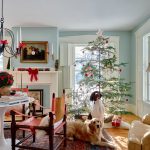Home Makeover Includes Painted Murals and Furniture
It takes a creative person to make a house a home. Artist Lisa Nelthropp did more than that when she purchased a property near New Hampshire’s Lake Winnipesaukee seven years ago. After evicting families of squirrels and bats who’d been in residence for years, Lisa realized maybe the former inhabitants didn’t really have it so […]
It takes a creative person to make a house a home. Artist Lisa Nelthropp did more than that when she purchased a property near New Hampshire’s Lake Winnipesaukee seven years ago.
After evicting families of squirrels and bats who’d been in residence for years, Lisa realized maybe the former inhabitants didn’t really have it so good. No heat or insulation existed in the summer home that was built in the 1780s and added onto in the 1830s. Floors, windows, and the roof needed to be replaced, and wastewater ran out of a hose into the backyard. “When I moved in, the whole thing was rotted,” says Lisa. “It was horrendous.”
She removed a set of stairs and the ceiling in the living room to expose the beams and give the room height. She took out a wall that separated the living area from the kitchen and added the ladder that provides access to a loft above. The kitchen island was salvaged from an old high school chemistry room.
After making the home livable, she didn’t have a lot of money for decorating, but Lisa, who at the time owned a cake-decorating business, scoured flea markets and garage sales looking for pieces that would work. She took bottles of Rit dye to a $10 wingback chair, turning the piece into something that looks like it came off the showroom floor. Another $9 went to a coffee table from a garage sale. Lisa made new Sheetrock walls look like old plaster by covering them as messily as she could with wax. A hand-me-down cabinet received a paint job, and Lisa had the good sense to add molding to the top and bottom, turning an eyesore into a beautiful display piece in the living room. “I found pieces in the trash, repurposed old furniture, bought things at a garage sales,” she says.
Lisa has no lack of creativity. She’s not sure where it even comes from. On a chilly October night six years ago, while she was making her last cake of the season, an idea came to her. She had just closed her business and had no plans for what she would tackle next. As she applied layers of icing and sugared flowers to the cake, she slammed her palms down on the table and declared out loud, “I’m going to paint in the style of Rufus Porter!” Lisa looked around and thought, Where did that come from? Lisa had never even seen an original painting by the famed early-19th-century muralist. Two months later, she completed a mural in the complex space that runs from her front door, up a steep staircase, and onto the landing above. A sea of water dotted with islands depicts the Caribbean and the ships sailed by her ancestors around St. Croix.
Lisa’s first commission came five months later. Soon after that, she did a four-story stairwell in a local show house that landed her six more jobs.
As she did with cake decorating, Lisa taught herself how to paint murals by reading everything she could about the art. When it came time to expand her already well-developed skills, she took classes on decorative painting, trompe l’oeil, wood graining, marbleizing, and plastering at the Institute of Surface Design in Boston. When she wasn’t working for others, her own home served as her practice canvas.
“Specialty painting is such a lost art,” says Lisa. “They just don’t do it anymore. I’ve got my own style — it’s developed and become more realistic and more Hudson River Valley looking. I think New England is all about these different artisans who continue crafts that are long forgotten, like blacksmiths or furniture makers.”







